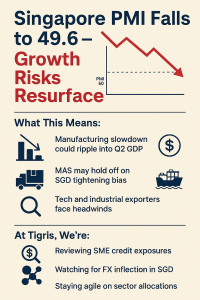
By Tigris Asset Management | May 2025
Singapore’s manufacturing Purchasing Managers’ Index (PMI) falls to 49.6 in April, dipping below the neutral 50-point mark for the first time in six months. While the move may seem incremental, it signals contraction—and in the broader context of rising global tariffs, fragile external demand, and shifting monetary dynamics, it’s a red flag that investors can’t afford to ignore.
Singapore PMI Falls – Why the Drop Matters
The PMI is a leading indicator of manufacturing health. A reading below 50 points to contraction, suggesting declining factory output, weaker new orders, and lower exports.
The breakdown matters:
- New Orders continue to shrink
- New Export Orders reflect subdued global demand
- Inventory levels are rising—signaling slower turnover
This confirms that external-facing sectors in Singapore, especially electronics and precision engineering, are now facing renewed pressure from both supply chain disruptions and soft global consumption.
Implications for the Macro Outlook
1. Manufacturing Weakness Could Hit Q2 GDP
Manufacturing makes up over 20% of Singapore’s GDP. A prolonged contraction could weigh heavily on second-quarter growth, especially if services activity slows in tandem. If Singapore PMI falls and remains below 50 into May/June, recession risk will rise.
2. MAS May Tilt More Dovish
Singapore’s Monetary Authority (MAS) uses the exchange rate—not interest rates—as its policy tool. A weakening manufacturing base could:
- Justify a pause in SGD appreciation
- Lead to a more neutral to accommodative policy stance in October
This aligns with what we’re already seeing—a slightly softer SGD across the board, as FX markets anticipate slower trade-driven inflows.
Implications for Investors
1. Sector Rotation in Equities
Manufacturing-heavy counters and exporters may underperform. Investors are likely to rotate toward:
- REITs (especially those exposed to domestic demand and logistics)
- Consumer staples
- Healthcare and telcos
Tech-linked industrials could see pressure if global chip demand falters amid ongoing tariff tensions.
2. Private Credit
At Tigris, we monitor PMI data closely to manage credit risk. Lower PMI typically leads to:
- Slower receivables collection
- Inventory build-up
- Margin pressure
For SMEs relying on trade-linked cash flows, this is a stress signal. Our Private Credit Fund focuses on secured, collateralized lending, with real-time cash flow monitoring and hedging strategies in place to cushion macro shocks.
Tigris Takeaway on Singapore PMI Falls
Singapore PMI falls in April may seem like a technical dip—but the context matters. Rising global tariffs, a fragile external environment, and FX volatility make this more than just a blip.
As always, we advise investors to:
- Monitor macro data like PMIs as early warning signals
- Adjust FX assumptions for SGD volatility
- Stay defensively positioned in both public and private markets
To learn more about how Tigris Asset Management is navigating current market conditions through private credit and tactical equity allocations, contact us or visit https://tigrisfunds.com


No Comments